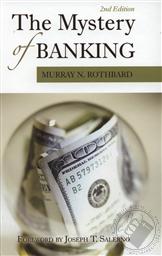The Mystery of Banking (Book/ Hardcover)
by Murray N. RothbardProduct Overview
Talk about great timing. Rothbard's extraordinary book unravels the mystery of banking: what is legitimate enterprise and what is a government-backed shell game that can't last. His explanation is clear enough for anyone to follow and yet precise and rigorous enough to be the best textbook for college classes on the topic. This is because its expositional clarity--in its history and theory--is essentially unrivaled.
Most notably, he uses the T-account method of explaining the relationship between deposits and loans, showing the inherent instability of fractional-reserve banking and how it sets the stage for centralization, inflation, and the boom-bust cycle.
But there is more. This book provides an explanation of money's origins and its meaning in the free market. The abstract theory is here, but always with real application to history and modern banking practice. Never does a paragraph go by without an example drawn from his massive knowledge of the subject.
Even further, he explains the integration between microeconomics and the business cycle. As Douglas French writes in the introduction: "Although first published 25 years ago, Murray Rothbard’s The Mystery of Banking continues to be the only book that clearly and concisely explains the modern fractional reserve banking system, its origins, and its devastating effects on the lives of every man, woman, and child. It is especially appropriate in a year that will see a surge in bank failures, central banks around the globe bailing out failed commercial and investment banks, double-digit inflation rates in many parts of the world and hyperinflation completely destroying Zimbabwe’s economy, that a new edition of Rothbard’s classic work be republished and made available through the efforts of Lew Rockwell and the staff at the Ludwig von Mises Institute. Priced affordably for students and laymen interested in the vagaries of banking and how inflation and business cycles are created."
Further, Joseph Salerno explains in the foreword: "The Mystery of Banking is perhaps the least appreciated work among Murray Rothbard’s prodigious body of output. This is a shame because it is a model of how to apply sound economic theory, dispassionately and objectively, to the origins and development of real-world institutions and to assess their consequences. It is “institutional economics” at its best. In this book, the institution under scrutiny is central banking as historically embodied in the Federal Reserve System—the “Fed” for short—the central bank of the United States.
"Rothbard’s presentation of the basic principles of money-and-banking theory in the first eleven chapters of the book guides the reader in unraveling the mystery of how the central bank operates to create money through the fractional-reserve banking system and how this leads to inflation of the money supply and a rise in overall prices in the economy. But he does not stop there. In the subsequent five chapters he resolves the historical mystery of how an inherently inflationary institution like central banking, which is destructive of the value of money, and in the extreme case of hyperinflation, of money itself, came into being and was accepted as essential to the operation of the market economy."
Incredibly, both authors correctly anticipate the current crisis -- and Rothbard explains it all and shows the way out. This is certainly the book for today, more essential than ever before.
About the Author(s)
Murray N. Rothbard
Murray N. Rothbard, the author of 25 books and thousands of articles, was a historian, philosopher, and dean of the Austrian School of economics. The S.J. Hall Distinguished Professor of Economics at the University of Nevada, Las Vegas, he was also Academic Vice President of the Ludwig von Mises Institute in Auburn, AL.
List Price: $18.00
Our Price: $16.00
You Save:
$2.00(11%)
+ Free Shipping w/ $45 min. purchase
Category: Business & Economics
Format: Book (Hardcover) (298)
Publisher: Ludwig von Mises Institute
Date Published: Sep 10, 2008
Language: English
ISBN: 9781933550282
SKU: LT-1290
Dimensions: 6.25 x 9.25 x 0.75 (in)
Weight: 19.60 oz










